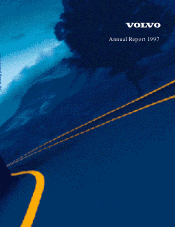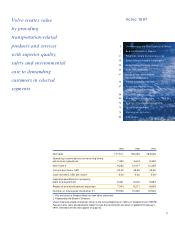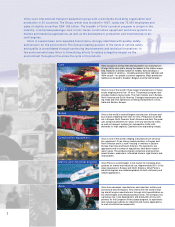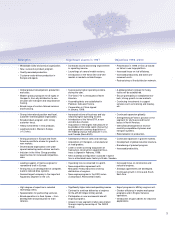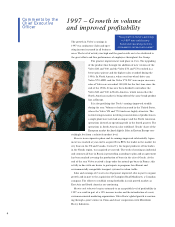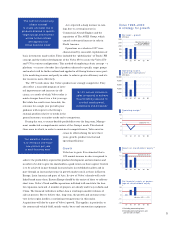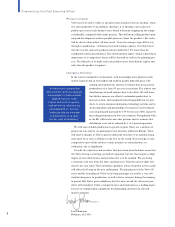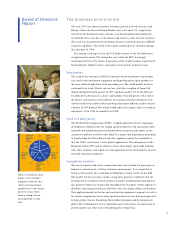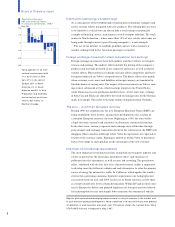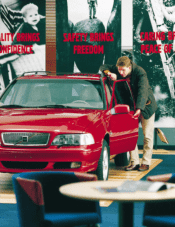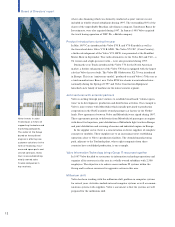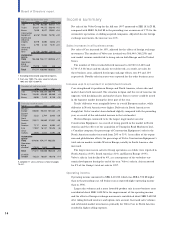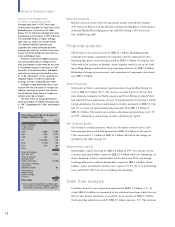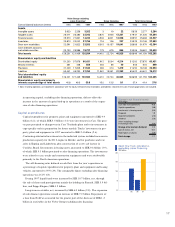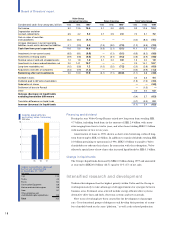Volvo 1997 Annual Report Download - page 10
Download and view the complete annual report
Please find page 10 of the 1997 Volvo annual report below. You can navigate through the pages in the report by either clicking on the pages listed below, or by using the keyword search tool below to find specific information within the annual report.
8
Board of Directors’ report
Volvo operates in an inter-
national environment with
11% of all sales in Swe-
den, 47% in the rest of
Europe, 28% in North
Am erica, 4% in South
Am erica and 8% in Asia.
Production and assem bly
are carried out on all con-
tinents, but mainly in
Northern Europe.
Information technology’s breakthrough
As a consequence of the breakthrough of information technology, transport and
service systems will be integrated with new products. The offering does not have
to be limited to a vehicle but can also include a total concept consisting for
example of financing, service, maintenance or total transport solutions. The truck
market in North America – where more than 35% of new-vehicle sales today are
being made through various types of leasing companies – is one example.
The use of the Internet to establish qualified contacts with customers is
another striking trend in the American passenger car market.
Foreign exchange m ovem ents affect com petition and earnings
Foreign exchange movements have both indirect and direct effects on competi-
tiveness and earnings. The indirect effects include the pricing of the company’s
products and materials procured in the respective currencies, as well as related
volume effects. Fluctuations in exchange rates also affect competitors and there-
by impact indirectly on Volvo’s competitiveness. The direct effects arise mainly
when revenues, costs, assets and liabilities in foreign currency are translated to
Swedish kronor at varying rates. The impact of these movements on Volvo’s earn-
ings is most substantial in Cars, which has large exports to the United States,
while Trucks has its own production facilities there. At the same time, earnings
in both Cars and Trucks are affected by the trend of exchange rates for the German
mark, for example. This is due to the large volume of purchases from Germany.
The euro – a common European currency
During 1998 the conditions for the new European Monetary Union (EMU) are
being established; these involve, among other developments, the creation of
a common European currency, the euro. Beginning in 1999, the euro will be
a legal electronic currency and constitute an alternative commercial currency.
In the short term, currency exposure and exchange costs will decline through
price changes and exchange transactions between the currencies in the EMU will
disappear. Most countries in Europe where Volvo has operations are expected to
be part of the currency union. Planning is underway within Volvo to determine
how to best adapt to and capitalize on the advantages of the new currency.
Important environm ental requirem ents
The most important environmental issues facing both the transport industry and
society in general are the increasing “greenhouse effect” and emissions of
pollutants into the atmosphere, as well as noise and crowding. The greenhouse
effect, combined with the fact that oil is a limited resource, makes it imperative
to develop more fuel-efficient vehicles and seek alternatives to oil as the primary
source of energy for automotive traffic. In California, which applies the world’s
strictest laws governing emissions, legislative requirements are being tightened
successively between now and 2005. In the rest of North America as well, there
is a trend toward lower levels of harmful emissions. Within EU and in other coun-
tries in Europe the debate and planned legislation are being focused on reduced
fuel consumption for cars and sharply lower emissions for commercial vehicles.
The Volvo Group’s
net comm ercial flows
in various currencies, 1997
billion SEK
ITL
JPY
GBP
Other
USD
20
–10
–20
10
0
NLG
DEM
SEK
BEF
–30
Regular, planned and coordinated product renewal is a key to success in the market and
to cost-effective product development. Volvo’s am bition is to have one m ajor new-product
introduction in each business area each year. The picture shows the 4-wheel drive Volvo
V70 R AWD that was introduced in May, 1997.

